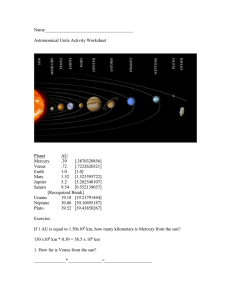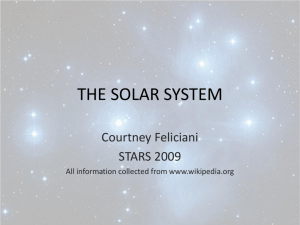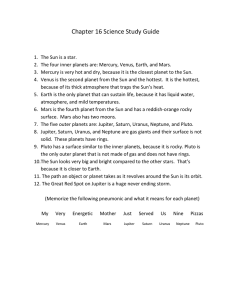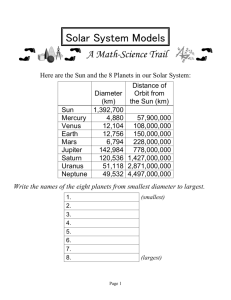Astronomy - Test 2
advertisement
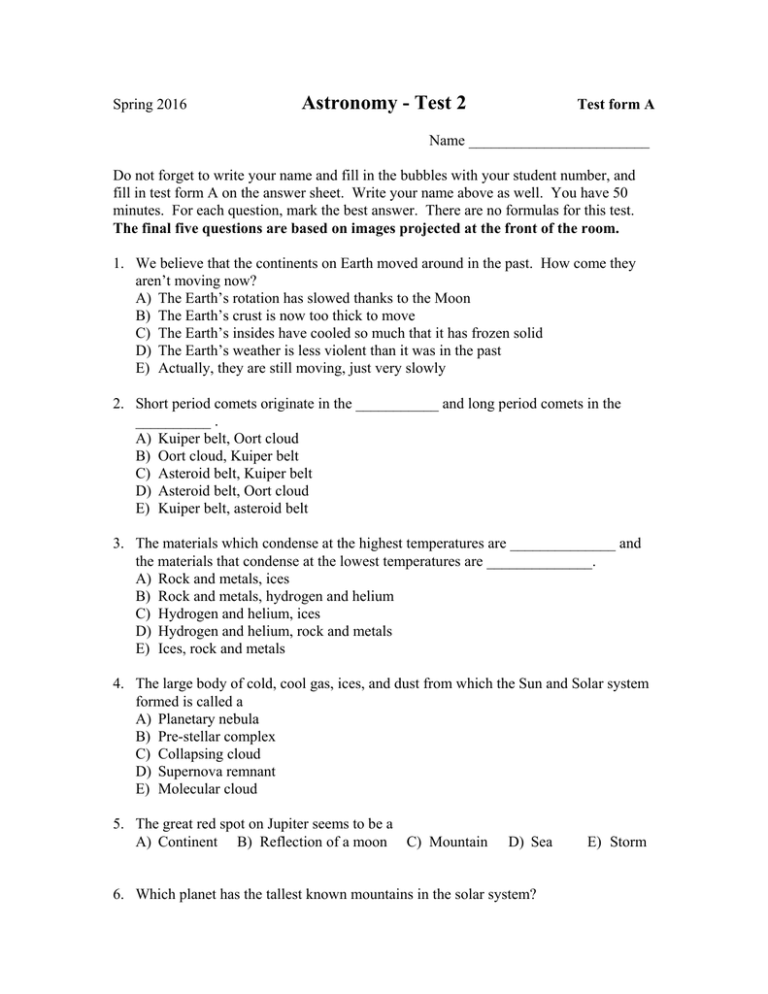
Spring 2016 Astronomy - Test 2 Test form A Name ________________________ Do not forget to write your name and fill in the bubbles with your student number, and fill in test form A on the answer sheet. Write your name above as well. You have 50 minutes. For each question, mark the best answer. There are no formulas for this test. The final five questions are based on images projected at the front of the room. 1. We believe that the continents on Earth moved around in the past. How come they aren’t moving now? A) The Earth’s rotation has slowed thanks to the Moon B) The Earth’s crust is now too thick to move C) The Earth’s insides have cooled so much that it has frozen solid D) The Earth’s weather is less violent than it was in the past E) Actually, they are still moving, just very slowly 2. Short period comets originate in the ___________ and long period comets in the __________ . A) Kuiper belt, Oort cloud B) Oort cloud, Kuiper belt C) Asteroid belt, Kuiper belt D) Asteroid belt, Oort cloud E) Kuiper belt, asteroid belt 3. The materials which condense at the highest temperatures are ______________ and the materials that condense at the lowest temperatures are ______________. A) Rock and metals, ices B) Rock and metals, hydrogen and helium C) Hydrogen and helium, ices D) Hydrogen and helium, rock and metals E) Ices, rock and metals 4. The large body of cold, cool gas, ices, and dust from which the Sun and Solar system formed is called a A) Planetary nebula B) Pre-stellar complex C) Collapsing cloud D) Supernova remnant E) Molecular cloud 5. The great red spot on Jupiter seems to be a A) Continent B) Reflection of a moon C) Mountain D) Sea 6. Which planet has the tallest known mountains in the solar system? E) Storm A) Mercury B) Venus C) Mars D) Earth E) Jupiter 7. Moving away from the Sun, the next planet after Saturn is A) Earth B) Venus C) Jupiter D) Neptune E) Uranus 8. For which planets do we think the magnetic fields are primarily generated in their water layers? A) Earth (only) B) Uranus (only) C) Neptune (only) D) Uranus and Neptune, but not Earth E) Earth, Uranus, and Neptune 9. The ultimate source of the heat that we find as we go into the Earth is A) Sunlight B) Heat of formation from when the Earth formed C) Chemical reactions inside the Earth D) Convection caused by Earth’s rotation E) Radioactive decay inside the Earth 10. Because Jupiter is so huge and has so much gravitational pressure, what is believed to the hydrogen deep inside Jupiter? A) It gets compressed and turned to diamond B) It undergoes combustion to become water C) It turns to a liquid metal that can conduct electricity D) It becomes solid E) It undergoes nuclear fusion 11. Venus is the hottest planet because of which greenhouse gas? A) Carbon monoxide B) Carbon dioxide C) Water D) Methane E) Sulfuric acid 12. Mercury orbits the Sun every 88 days. Which of the following might be the orbital period for Venus? A) 59 days B) 225 days C) 1.9 years D) 12 years E) 29 years 13. Which of the following is one of the ways responsible for the discovery of hundreds of planets around other stars? A) The transit method, where the star’s light is blocked by the planet as it passes in front B) Direct observations, where high-quality images are searched for dim planets next to the stars C) Robotic missions that travel to the stars to check for planets D) Searches for particular wavelengths of light that are only emitted by planets, not stars E) Gravitational perturbations on the Earth’s orbit by those planets 14. Why is it that planets like Earth have metal in the middle, then more rock on the outside? A) Metal has a higher condensation temperature, so it formed first B) Magnetic fields attract metal to the center of the Earth C) Metal is heavier than rock, and gravity pulls it to the center D) The rock was deposited by giant impacts that came later than the formation of the core, probably at the same time the Moon formed E) Only rock can flow out of volcanoes, therefore rock is on the outside of Earth 15. Even before we retrieved samples from the dark maria on the Moon, we thought they would turn out to be younger than other parts of the Moon. Why did we expect this? A) The maria show less weathering B) The maria are near regions where there is continental formation on the Moon C) The maria are the highest spots on the Moon, proving they were added later D) The maria have fewer craters than other parts of the Moon E) The maria have not accumulated as much atmosphere as other parts of the Moon 16. Miranda is a moon of A) Uranus B) Neptune C) Mars D) Jupiter E) Saturn 17. When the protoplanetary nebula contained only tiny bits of dust and ice, how did these pieces come together to make slightly larger pieces? A) They were all orbiting, and occasionally would just collide B) Gravity pulled them together C) Electric forces pulled them together D) Magnetic forces pulled them together E) Nuclear forces pulled them together 18. Which two factors account for the fact that Mercury has both very high temperatures AND very low temperatures? A) Slow rotation and no atmosphere B) C) D) E) Slow rotation and uneven volcanic activity No atmosphere and uneven volcanic activity No atmosphere and a highly elliptical orbit Slow rotation and a highly elliptical orbit 19. Which of the following materials was most common in the protoplanetary disk from which the Earth and other planets formed? A) Ices B) Dust C) Hydrogen and helium D) Rock E) None of these 20. Which of the following planets does not have any moons? A) Uranus B) Mars C) Neptune D) Mercury 21. Which of the following is an asteroid? A) Pluto B) Eris C) Ganymede D) Triton E) Saturn E) Ceres 22. On which object can be found rivers and lakes, but not filled with water? A) Triton B) Miranda C) Io D) Titan E) Europa 23. Which of the following planets has one or more rings? A) Mercury B) Mars C) Venus D) Neptune E) None of theses 24. The largest component of Saturn’s rings is A) Hydrogen B) Helium C) Ice E) Rock D) Metal 25. How come large asteroids never collide with the Earth? A) They are all in the asteroid belt, between Mars and Jupiter B) Earth’s moon acts as a shield, blocking all such asteroids C) There are so few asteroids, in total, that even in a billion years there have probably never been any significant collisions D) The Earth’s atmosphere is so thick that it can stop even the largest asteroids E) Actually, there have been several collisions; one of them probably wiped out (most of) the dinosaurs 26. Planet’s first or primary atmospheres formed how? A) They were made by the photodissociation of water and other ices B) They were released by volcanoes C) They were released by boiling oceans of liquid atmospheres by the young Sun D) They were gravitationally attracted from the protoplanetary disk E) They are actually the accumulation of the solar wind 27. How is it that we can know the masses of other planets, such as Jupiter? A) We know their composition, and by measuring the volume, we figure out the mass B) We can measure their gravitational pull on moons or spacecraft near them C) We can tell by the amount of heat they produce how much matter they must have D) We can predict their masses solely on the basis of their position in the solar system E) We have sent probes to them, which can drill to their centers and deduce the mass 28. Some meteorites are almost pure metal; others are nearly pure stone. This tells us that A) They must have formed in different regions of the solar system at different temperatures B) They must once have been parts of much larger objects that were differentiated C) They must have once have had magnetic fields that attracted or repelled metal D) They must have been broken off from different planets, which have different compositions E) They must have formed from different parts of the protoplanetary disk For each of the following, please look at the pictures on the screen to identify the object. 29. What are these pictures of? A) Titan B) Venus C) Iapetus D) Triton E) Miranda 30. What is this a picture of? A) Mercury B) Moon C) Ganymede D) Uranus E) Europa 31. What is this a picture of? A) Earth B) Venus C) Jupiter D) Saturn E) Neptune 32. What is this a pictures of? A) Titan B) Io C) Mars D) Neptune E) Uranus 33. What are these pictures of? A) Io B) Mercury C) Ganymede D) Europa E) Mars

